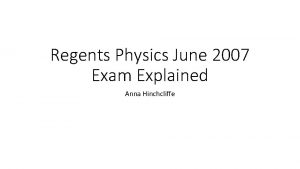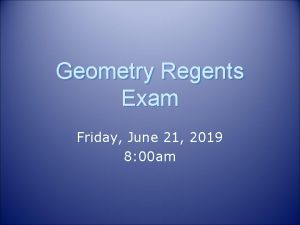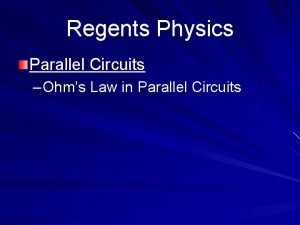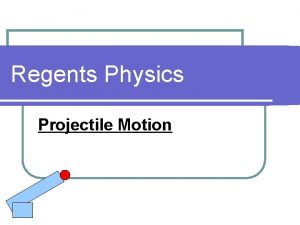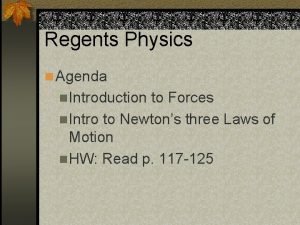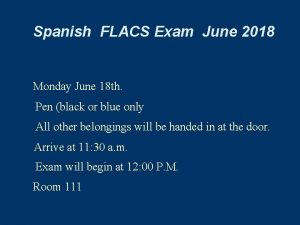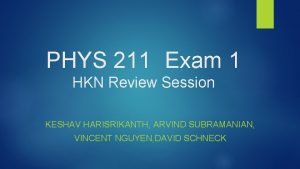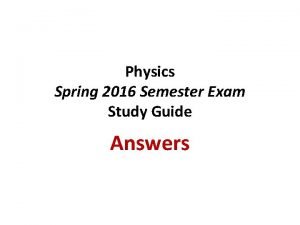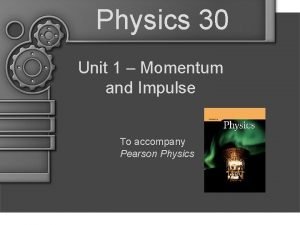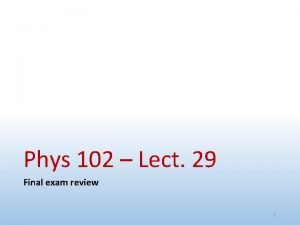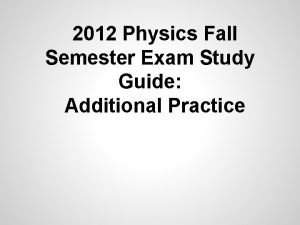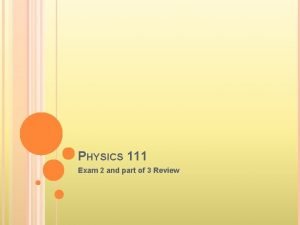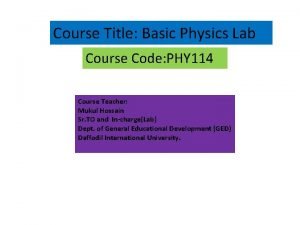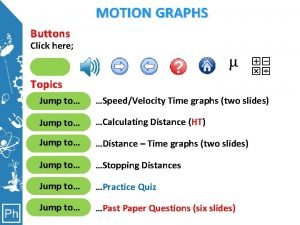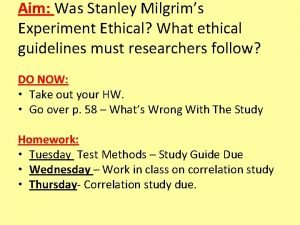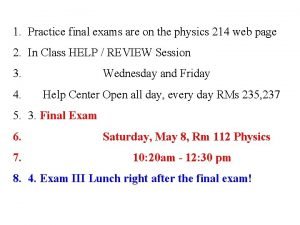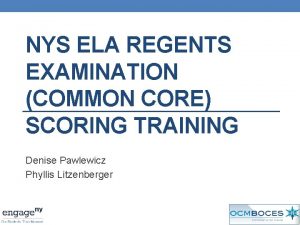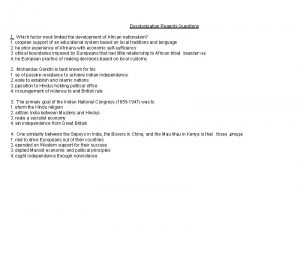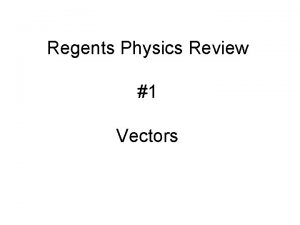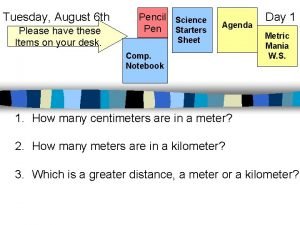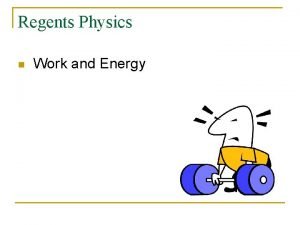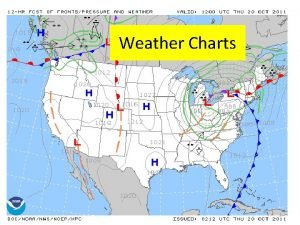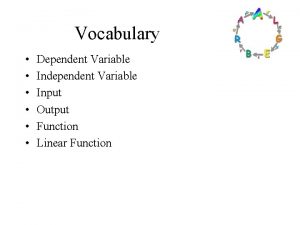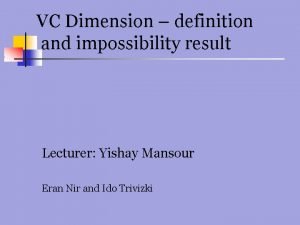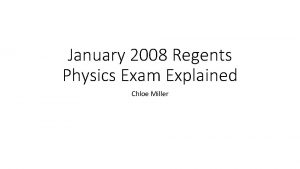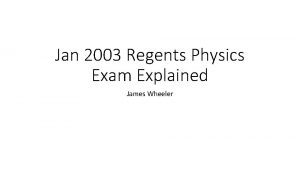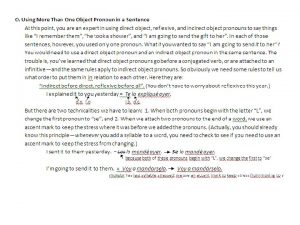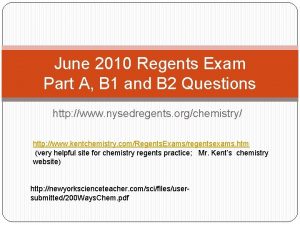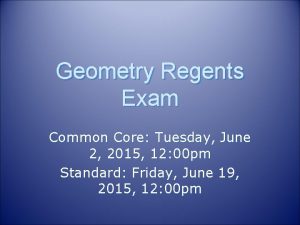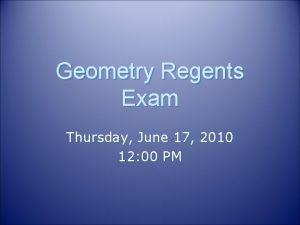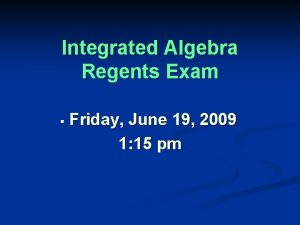Regents Physics June 2007 Exam Explained Anna Hinchcliffe




















































































- Slides: 84

Regents Physics June 2007 Exam Explained Anna Hinchcliffe

Part A- #1 • A vector is something that is measured in magnitude and • So, if you move a distance of 3 direction meters north and 4 meters east, you have a total displacement • A scalar is something measured (vector) of 5 meters only in magnitude • So 5 m/s is speed (scalar), while 5 m/s east is velocity (vector) • Another example is distance vs. displacement

Part A #1 • Magnetic field strength at a given point has a certain strength and • Therefore, the only choice that is direction, making it a vector not a vector is #1, electric charge • Electric charge is a scalar because it only has magnitude, for example a charge of 3 coulombs • Electric charge has no direction associated with its magnitude

Part A #2 • We have the distance (6 m), and the time (2. 7 s) • We also have the initial velocity (0 m/s) • the unknown is acceleration • The formula for that best fits these variables is:

Part A- #2 • After you solve for the unknown, you then plug in all your numbers and solve the equation • So, the answer is #1, 1. 6 m/s 2

Part A-#3 • We have the mass (2 kg), the weight (19. 6 N) and the • So the mass would still be 2 kg, so acceleration due to gravity on the answer is #2 2) Mars (3. 71 m/s • But the question is asking what the mass is on Mars compared to the mass on Earth • The mass of an object stays constant no matter what planet it’s on, while the weight changes

Part A-#4 • When an object is moving in a circle, the acceleration is constantly changing • The velocity is pointed in tangent • The acceleration is pointed to the circle toward the center too • And the centripetal force is pointed towards the center of the • So in the problem, the acceleration is pointed towards circle the east, #4

Part A #5 • Two concurrent forces are two forces acting at the same time on an object at the same point • To reach equilibrium, the net force (total of all force acting on an object) needs to equal zero • As the angle between 2 concurrent forces decreases, the resultant force increases • So, since the resultant force increases, it would take a larger force in the opposite direction to reach equilibrium • The answer is #2, increases

Part A #6 • Displacement is the scalar quantity of the change in an objects position • So, if a kid walks 5 meters north, 4 meters east, the 2 meters south • The kid ends up 4 m east and 3 m north from the start • Using Pythagorean theorem you find the total displacement is 5 m • So the answer is #2, 5 m

Part A #7 • We know that x, the change in position of the spring is 0. 075 meters, and the force acting on the spring is 5 Newtons • The equation for the spring constant ‘k’ is • By solving the equation we see the answer is #2, 67 N/m

Part A #8 • We have he mass (0. 5 kg), the radius (0. 25 m), and velocity (4 m/s) • The unknown is the acceleration of the circular path • The equation for centripetal • After solving the equation we see acceleration is : that the answer is #4, 64 m/s

Part A #9 • For this problem, we know the • Momentum can also be measured mass of the cart is 1 kg by the force times time, or p=Ft • We also know momentum(p) is measure by the equation p=mΔv • So by measuring each option we’ll find out which has the most • By solving these equations momentum we see that #3 has the most momentum of 10 N/s

Part A #10 • We know that the moons mass is force, they exert on each other is m, we also know the earths mass equal is 81 m and the gravitational force • So, the answer is still F, #1 the earth exerts on the moon is F • The unknown is the gravitational force the moon exerts on the earth • Because there is no change in the mass or distance between these two objects the gravitational

Part A #11 • The known variables we are given are mass and speed • Kinetic energy is measured by the equation of KE=1/2 mv 2 • So if we figure out what each objects KE is we can figure out which two are equal • By solving the equations we find Band C are equal, so choice #4 is the answer

Part A #12 • The given variables are force (5 N), • After solving the equations, we see the answer is #3, or 30 J mass (3 kg), and distance (6 m) • The unknown is the kinetic energy • The kinetic energy plus the potential energy is equal to the total energy • The total energy is equal to Force times distance

Part A #13 •

Part A #14 •

Part A #15 •

Part A #16 •

Part A #17 • We know the first wire has a resistance (R), length (L), and cross-sectional area (A). • We also know since both wires are copper, they have the same resistivity (p) • The formula for resistance is • So to find the resistance of the second wire we can plug in the values of 2 L and 1/2 A to the equation • By doing his we find the answer is #4, 4 R

Part A #18 • In a circuit, we know that voltmeters must be in series with the lamp, and if the switch is open, the lamp won’t operate correctly • So we know that #1 and #2 are not correct, and #3 isn’t either, because they are all parallel circuits • So the answer is #4

Part A #19 • To better understand this, we can • The formula for this is draw out the circuit, which is • After we solve for the unknown, parallel we plug in the numbers • Since each lamp has the power of 100 watts, the total power is 6000 W • The and the total voltage is 120 V • We then find the answer to be #1, 5 A

Part A #20 • The known variables are voltage (4. 5 V) electrical energy, or work (1950 J) and time (1 hr) • The unknown is the resistance, R • The formula is • And we need time in seconds, so 1 hr is 3600 secs • Know we plug in the numbers to • The answer is #3, 37. 4 ohms find the resistance

Part A #21 •

Part A #22 • The amplitude of a wave is the maximum displacement of a particle, or how high/low the wave goes from its rest point • So the distance between A and D, or A and E shows the amplitude • The answer is #3, A and E

Part A #23 • In phase means the two points are 0˚ or 360 ˚ apart • Or they show two points in the same position • So in the diagram, point C is in • So for example, the points shown phase with point P below are in phase • The answer is #3, C

Part A #24 •

Part A #25 •

Part A #26 •

Part A #27 • We know electromagnetic waves do not need a medium to travel through • Radio waves and infrared waves are both also electromagnetic • So sound is the only option that is not electromagnetic, and sound needs a vacuum to travel through • So the answer is #4, sound

Part A #28 • When vibrations or wave energy is transferred from one object to another, this is called resonance • So when the energy of the car at a certain speed causes the glove box to vibrate, energy is being transferred • This is resonance • The answer is #3, resonance

Part A #29 • Diffraction is caused when a wave passes through an opening, and this causes the waves to spread out • The smaller the opening, the greater diffraction • So the answer would be #1, 0. 2 mm

Part A #30 • Constructive interference is when two waves meet and form a new wave with a greater amplitude • When the waves meet, the greatest interference would be if they met at the same point • So the answer is #1, 0˚

Part A #31 • When a source of sound is moving, the observed frequency (pitch) from a fixed point appears • So the answer is #4, lower in to change pitch • For example when a siren on a car is moving toward someone, it sounds like the pitch is getting higher • So when the whistle is moving away from the student, the observed sound is lower in pitch

Part A #32 •

Part A #33 •

Part A #34 • Light is on the reference table as an electromagnetic wave • It is also however considered a particle because it has tiny ‘packets’ of energy called photons • So light is a particle and a wave • The answer is #3, both

Part A #35 •

Part B-1 #36 •

Part B-1 #37 •

Part B-1 #38 • To understand this question, we can draw it out • We then draw out the resultant velocity • We use Pythagorean theorem to find the resultant • We find the answer to be #2, 2. 5 m/s

Part B-1 #39 •

Part B-1 #40 •

Part B-1 #41 • We can draw out a picture for this question • And we also need to understand that when you throw a ball up, it starts with a velocity of 0 m/s and • So from this we can get the increases answer to be #4 • Then at the peak of the throw, the ball stops and beings to fall, going into a negative velocity

Part B-1 #42 • We know the momentum of a system is equal to the momentum after • So if A has more momentum to the right and it collides with B which has a little less momentum to the left • The answer is #2 • We can assume that the momentum will be a small amount to the right

Part B-1 #43 • We can draw out a pendulum for this • We see as the pendulum is released from the side, its height decreases • The formula for potential energy is PE=mgΔh it also increases • So as height decreases, PE decreases • So the answer is #4 • But, after it reaches the low point,

Part B-1 #44 • The formula for power is P=Fv • ‘v’ being the speed or velocity of the elevator • So, if speed increases, then the power will also increase • This makes a direct relationship • So the answer is #1

Part B-1 #45 • A baryon is a subatomic particle that has an odd number of valence quarks • By looking at the reference table we see quarks are amounts of electrons • And the only option without an even number is option 3 • So the answer is #3, -1 e and +1 e

Part B-1 #46 • Planks constant is the amount of energy a photon carries with the frequency of its electromagnetic wave • So from this we know that the answer must be #1, plank’s constant

Part B-2 #47 • We know electric field lines flow from positive to negative • So if we draw the two plates, the field lines will look like this:

Part B-2 #48 •

Part B-2 #49 -

Part B-2 #503 • We can use the data points from the previous question to answer these • We can make a graph where frequency is the x and wavelength is the y • Once the points are plotted, we connect them with a curved line

Part B-2 #52 •

Part B-2 #53 • We know the sled is moving at a constant velocity, meaning no acceleration • This means it is in equilibrium and the horizontal force is equal to the frictional force • So from the previous answer we know the horizontal force is 52 N • And therefore the frictional force has to be 52 N

Part B-2 #54 •

Part B-2 #55 • • the projectile is launched at an angle of 30˚ Projectiles launch and rise, and at the top stop, then start to fall Looking like a parabola So the path would look like this:

Part B-2 #56 • When you increase the angle of launch from 30 to 45 degrees, and the initial velocity is the same • The altitude will increase

Part B-2 #57 • Because the angle of launch is changed from 30 to 45 degrees, the altitude increases • But the horizontal distance will decrease

Part B-2 #58 • The formula for resistance is • And we know the voltage is 12 V and the current is 5 A • So we can solve for the resistance using these

Part B-2 #59 • The formula for current can be derived from the formula for resistance • We know the voltage is 12 V and the resistance is 3 ohms • So we Can solve for the unknown to find the current

Part B-2 #60 • We can use the formula for the total resistance • And we know the total resistance is 2. 4 ohms, and the first resistor is 3 ohms • So we can solve for the equation to find the unknown resistance

Part C #61 • The normal force is the force up on an object supporting another object, its equal to the weight of the object • For example, the box’s normal force is acting up from the surface • And if the box weighs 20 N, then the normal force is 20 N • And if 1 cm is equal to 4 N, the vector would be 5 cm • So we can draw a vector perpendicular to the surface of 5 cm

Part C #62 • The formula for frictional force is • To find mu, we can look it up in the reference table • The box is moving so we need kinetic coefficient of friction • The mu for kinetic wood on wood is 0. 30 • And the normal force is 20 N • So we can solve the equation to find the frictional force

Part C #63 • The net force is the total of all force acting on an object • We know the normal force, 20 N the horizontal force is 8 N the frictional force is 6 N and the weight is 20 N • We can draw this out in a diagram • So we can see that the forces equal up to a net force of 2 N

Part C #64 •

Part B-2 #65 • The formula for acceleration is F=ma • The ‘F’ being the net force of 2 N and the ‘m’ being the mass of 2 kg • We can solve for the unknown ‘a’ • and plug in the variables to find the acceleration 1 m/�� ^2

Part C #66 •

Part C #67 • The formula for gravitational PE is PE=mgΔh • We know the PE of the spring was 0. 19 J, and we know the mass of the toy is 0. 020 kg, and ‘g’ is -10 m/s^2 • So if we set the equation equal to 0. 19 J , we can solve for the unknown of max height, ‘h’ • To find the max height of 0. 97 m

Part C #68 • For this problem you need a protractor to measure the angle • From measuring, we see the angle to be about 17˚

Part C #69 • To find the angle of refraction, we can use this formula: • From the ref. tables we know the ‘n, ’ the index of refraction for air is 1. 00 and the ‘n’ for fused quartz is 1. 46 • And we know the angle of incidence is 17˚ • So we can solve for the unknown to find the angle of refraction

Part C #70 • We know from the previous question that the angle of refraction is 12˚ • So to draw this we need to use a protractor and ruler

Part C #71 • So for this one we know the angle of incidence=angle of reflection • So both angles should be about 17˚ • Use a straightedge and protractor

Part C #72 •

Part C #73 •

Part C #74 • To find this we can look at the reference tables for the energy levels of a hydrogen atom • And the photon has an energy of 2. 08 e. V • So if we look on the table, we see that value is in the 3 rd level • So n=3 is the answer

DONE!







 June 2007 physics regents
June 2007 physics regents Horses hate surprise parties
Horses hate surprise parties June 2010 chemistry regents
June 2010 chemistry regents June 21 2019 geometry regents
June 21 2019 geometry regents January 2016 chemistry regents answers
January 2016 chemistry regents answers January 2012 chemistry regents
January 2012 chemistry regents Parallel circuit laws
Parallel circuit laws Regents physics work power energy
Regents physics work power energy Work and energy
Work and energy Projectile motion regents questions
Projectile motion regents questions Physics regents
Physics regents Spanish flacs exam 2018 answers
Spanish flacs exam 2018 answers Grade 7 life orientation term 2 notes
Grade 7 life orientation term 2 notes Flacs checkpoint b spanish exam
Flacs checkpoint b spanish exam Flacs exam 2020
Flacs exam 2020 Physics 211 exam 1
Physics 211 exam 1 Physics semester 1 final exam study guide answers
Physics semester 1 final exam study guide answers Physics 20 final exam practice
Physics 20 final exam practice Physics 30 momentum and impulse
Physics 30 momentum and impulse Physics 102 final exam
Physics 102 final exam Physics fall semester review answers
Physics fall semester review answers Physics 1 exam 2 review
Physics 1 exam 2 review Physics exam 2 review
Physics exam 2 review Physics 111 exam 2
Physics 111 exam 2 Physics 1 lab final exam
Physics 1 lab final exam Click graph
Click graph Milgrim experiment
Milgrim experiment Physics 101 final exam
Physics 101 final exam Why does it happen
Why does it happen University physics with modern physics fifteenth edition
University physics with modern physics fifteenth edition Hl physics ia ideas
Hl physics ia ideas Us history regents review
Us history regents review On which station model would the present weather symbol
On which station model would the present weather symbol Regents periodic table
Regents periodic table Tristan denley
Tristan denley The beaks of finches, student laboratory packet answer key
The beaks of finches, student laboratory packet answer key Earth science lab practical
Earth science lab practical Colligative properties regents questions
Colligative properties regents questions Chemistry regents 2011
Chemistry regents 2011 Nys ela regents argument rubric
Nys ela regents argument rubric Mole conversion chart
Mole conversion chart Louisiana board of regents
Louisiana board of regents Earth science regents part d
Earth science regents part d Earth science regents lab practical
Earth science regents lab practical Kent chemistry reference table
Kent chemistry reference table Regents policy 5402
Regents policy 5402 What were two indirect results of the crusades
What were two indirect results of the crusades Historians value the writings of ibn battuta because he -
Historians value the writings of ibn battuta because he - Decolonization regents questions
Decolonization regents questions Crq global regents
Crq global regents Regents biology food chains and energy in ecosystems
Regents biology food chains and energy in ecosystems 282 ways to pass the earth science regents
282 ways to pass the earth science regents Us history regents practice
Us history regents practice Global regents thematic essay topics
Global regents thematic essay topics Regents solubility table
Regents solubility table United states history and government regents
United states history and government regents Regents chemistry midterm
Regents chemistry midterm Chemistry bonding regents questions
Chemistry bonding regents questions How to start an enduring issues essay
How to start an enduring issues essay The diagram below represents a 155 newton box on a ramp
The diagram below represents a 155 newton box on a ramp Characteristics of life regents questions
Characteristics of life regents questions Comprehensive english regents
Comprehensive english regents La board of regents
La board of regents Dhhdnf
Dhhdnf Global 9 regents
Global 9 regents Ccela
Ccela Regents
Regents How to write an enduring issue essay
How to write an enduring issue essay Evison regents
Evison regents Metric mania answer key lesson 2 mass
Metric mania answer key lesson 2 mass Fs=kx
Fs=kx Regents of university of california v bakke
Regents of university of california v bakke Paper chromatography is a method used in regents
Paper chromatography is a method used in regents Regents
Regents Rocks cluster tutorial
Rocks cluster tutorial Regents
Regents Evison regents
Evison regents Alviz biz resources
Alviz biz resources Endocrine system regents questions
Endocrine system regents questions Endocrine system regents questions
Endocrine system regents questions Regents professor emeritus
Regents professor emeritus Prog chart legend
Prog chart legend Water column explained
Water column explained Dependent variable vs independent variable
Dependent variable vs independent variable Vc dimension explained
Vc dimension explained
